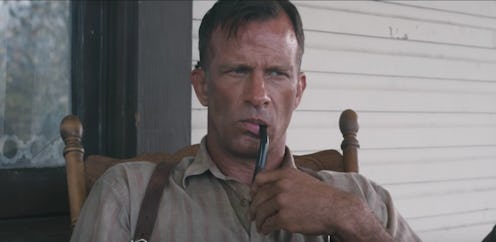Entertainment
Netflix's New Murder-y Stephen King Movie Is Going To Creep You The Eff Out

It's 1922, and Wilfred James is at his breaking point. Tired of fighting with his wife, Arlette, about their farmland in Nebraska and weary of the cost of divorce, Wilfred decides to kill his wife. And that's when things really get started in Netflix's new film 1922. The psychological thriller is adapted from the Stephen King novella of the same name, but it might surprise viewers to learn that, while 1922 isn't based on a true story, it is inspired by real events.
King's story 1922, published in the collection Full Dark, No Stars in 2010, is, like most of King's most famous scary stories, mostly fiction. Wilfred James, the narrator, is a made up antihero; his crimes — convincing his teenage son Henry to help him kill his wife — were never committed. However, King took inspiration from one or more real life crimes to write the novella. On his official website, King writes that "1922" was inspired by the nonfiction book Wisconsin Death Trip (1973). The book is a collection of photographs, including many haunting photos and details of various scandals and crimes that took place in the small town of Black River Falls, Wisconsin. "I was impressed by the rural isolation of these photographs, and the harshness and deprivation in the faces of many of the subjects," reads King's online statement. "I wanted to get that feeling in my story."
Wisconsin Death Trip is, essentially, a photo-book, which means it's not exactly a historical account of the late 19th century goings on of Black River Falls. However, the book is comprised of actual photos and newspaper clippings which detailed the horrors that befell the town in the 1980s. A review of the 1999 drama Wisconsin Death Trip, based on the book, in the Chicago Tribune described the Black River horrors as "a string of murders and suicides, epidemics of diphtheria and smallpox, rumors of witchcraft and a series of catastrophic financial failures." So it's no surprise King, long considered a master of the horror genre, found adequate inspiration for 1922 in the photo book.
It's unclear whether or not a Wilfred James appears in the book. But it seems obvious that, even if there really was a Wilfred James who killed his wife, the story King tells in "1922" takes many liberties. For example, the story details how Wilfred descends into madness stemming form his guilt, so much so that he begins seeing his wife's ghost in his home. Unless you believe in ghosts, this might seem pretty far-fetched for a true story. And that's not even taking into account the fact that Wilfred is an extremely unreliable narrator.
There's no doubt that King was inspired by real life events and photographs when he wrote "1922," but the film from director Zak Hilditch didn't remind him of the original photos. Instead, King compared Netflix's 1922 to another fictional film, 2007's There Will Be Blood. "It had that same kind of flat, dead-eyed, affect to it," he said in an interview with Vulture. "It has this sort of poisonous effect, it just sort of sticks there because some of the images are so good." What began as a story inspired by Wisconsin Death Trip has apparently eclipsed its original roots in historical events, and if it's OK with King, fans should be just fine.
Fact or fiction, 1922 certainly does not fail to make an impression. Audience members afraid of everything from murder to rats will find more than enough moments in the film absolutely terrifying. Let's just hope it doesn't remind you of anyone you know IRL. The last thing Netflix needs is a 1922 sequel actually based on a true story.